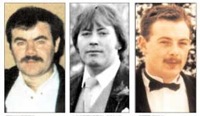
Three IRA Volunteers were shot dead by undercover British forces fourteen years ago this week.
Shortly before 7.30am, on 3 June 1991, three Volunteers of Tyrone Brigade, who were on active service, drove towards Coagh village from the direction of Moneymore. In the commandeered red Vauxhall Cavalier they carried two weapons. Their car had just crossed a small bridge leading into Coagh’s main street, having passed a number of workmen. As the car entered the edge of Hanover Square, it passed a red Bedford lorry parked near the kerb. This lorry had, according to local people, not been seen in the village before and appeared to have been part of the crown forces’ operation. Behind this lorry and in other hidden locations around Hanover Square, eight SAS gunmen lay in wait. From eyewitness accounts it appears that all were armed with heavy calibre assault rifles and at least one was carrying a machine gun.
As the Volunteers’ car cleared the Bedford lorry it came under intense fire. All three occupants appear to have been hit by this initial burst. The vehicle went out of control, veered across Hanover Square and crashed into a garden wall. Without letting up their fire, eight of the gunmen closed in on the stricken vehicle. The SAS killers assumed positions in a semi-circle around the car and continued firing for up to ten minutes. The Cavalier, struck from all quarters, burst into flames, the blaze igniting a Volkswagon Golf parked at the scene of the crash.
At least 200 rounds hit the car; others tore around the windows of nearby buildings. One of the SAS gunmen emerged from an alleyway between two houses, took up position less than ten yards from the front of the car, and fired round after round into the vehicle. A resident of one of the houses later told how she had seen this gunman at the rear of her house just before the shooting started. She described him as wearing ‘a type of gas mask and some kind of boiler suit’, a description of the type of apparel often worn by SAS death squads.
The three Volunteers who were brutally slain were Tony Doris from Coalisland, Pete Ryan from Ardboe, and Lawrence McNally from Ballinderry.
Less than an hour after the ambush ceased, stories of a ‘gun battle’ were being fed to a media only too willing to carry the official version of events without question. At the same time, the RUC ‘unofficially’ give the names of the three dead men to journalists, a clear indication that the ambush had been very carefully prepared and that the three had been under surveillance and could easily have been arrested.
The main RUC line and the one which drew most media attention was the lie that the Volunteers were en route to shoot Protestant workmen when they were ambushed. This was carried even though the media were aware that the Volunteers’ car had already driven past the workmen before the shooting began. An IRA statement made clear that the Volunteers were on active service preparing to engage a military target.
The execution of the triple killing and the firepower employed by the British death squad were designed to deliver two messages. The first was that the shoot-to-kill policy sanctioned and overseen by the highest levels of the British administrations was still firmly in place. The second was that those who dared to resist British rule would be met with the full force of a violent and well-armed state, prepared to use both official and unofficial death squads to silence and eliminate those who would not be cowed.
IRA Volunteers Pete Ryan, Lawrence McNally and Tony Doris were fighting a war of liberation. They knew it was likely that they would be killed in that war and their deaths were terrible casualties of it. Their role had been clear, honest and honourable. The British Government’s was the opposite.
Despite unnecessary delay and harassment by the RUC and the Gardai, the three Volunteers were buried with military honours; thousands turned out to honour the fallen freedom fighters.
![[Irish Republican News]](https://republican-news.org/graphics/title_gifs/rn.gif)
![[Irish Republican News]](https://republican-news.org/graphics/title_gifs/harp.gif)

